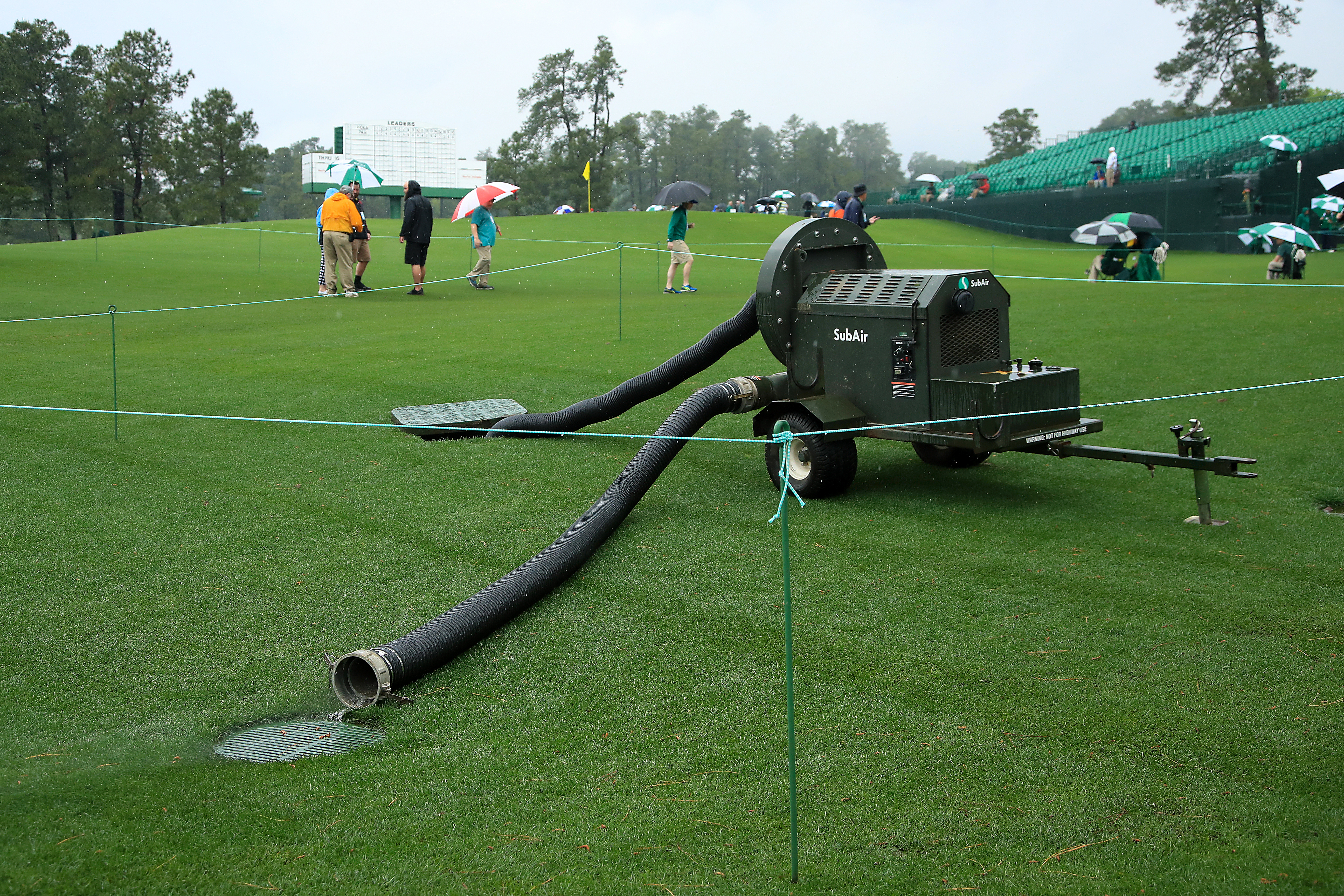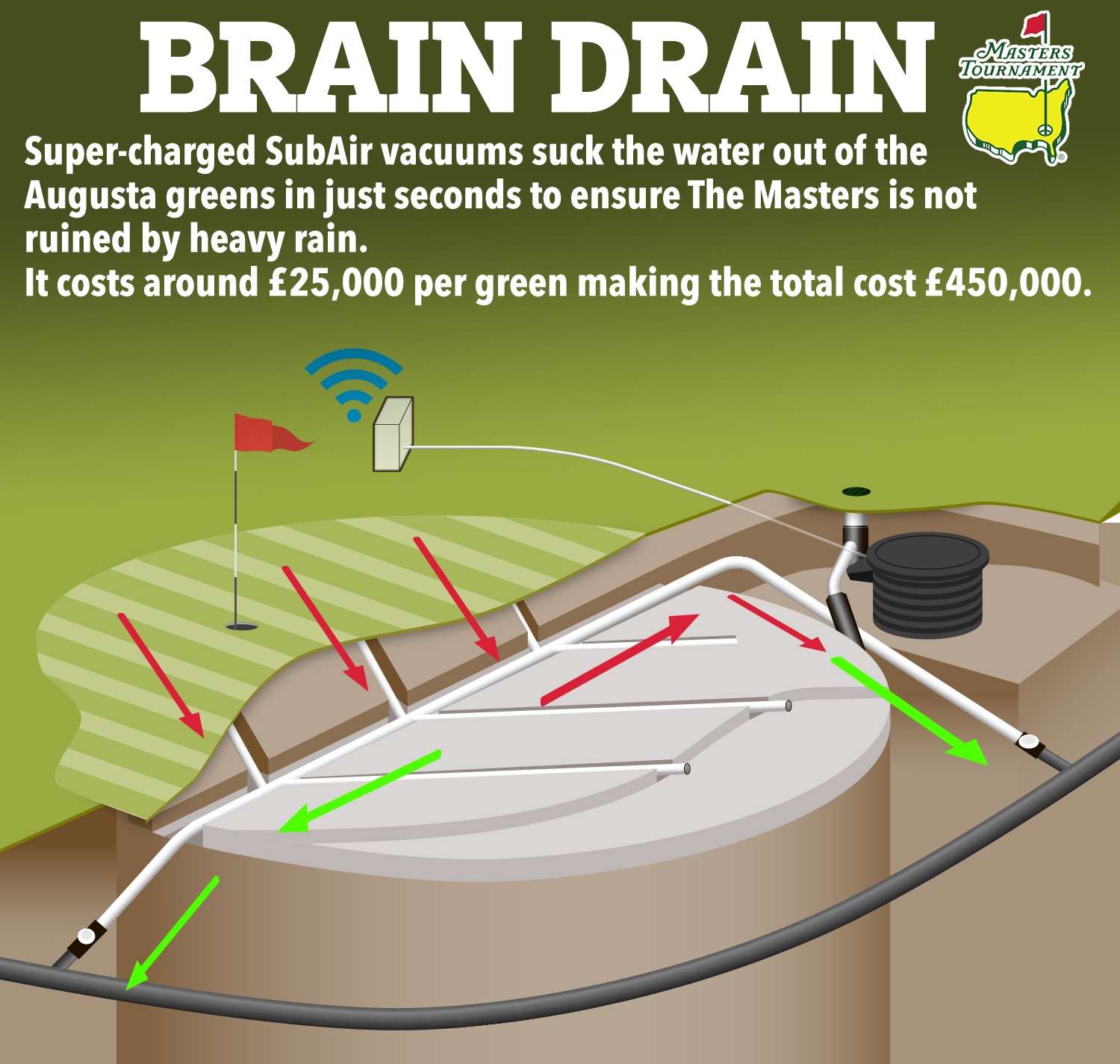Revolutionary Technology at The Masters
As rain looms over Augusta, concerns about play conditions arise. But fear not, the SubAir system at the Masters can make puddles vanish in just 30 seconds, ensuring smooth gameplay even in heavy downpours.
Unveiling the SubAir System
The SubAir system provides aeration, moisture removal, and root zone temperature control, creating an optimal growing environment for green grass. Essentially, it can swiftly remove rainfall from the playing surface, keeping the greens dry and pristine.
How It Works
The SubAir system is seamlessly integrated into the existing drain system of a green, with a blower/vacuum machine, pipes, valves, and sensors. By sucking water and air through the turf, it efficiently drains water and enhances growing conditions through aeration and temperature control.
A Brief History
The first Augusta green to have the SubAir system was the 12th, known for flooding. The system's success led to its widespread installation. Today, over 500 golf courses, including Congressional and TPC Sawgrass, benefit from SubAir technology.

The Cost of Innovation
While the SubAir system is a game-changer for maintaining golf course quality, it comes at a price. Costing around £25,000 per green, plus power supply expenses, golf clubs must invest significantly to enjoy its benefits.
Frequently Asked Questions
What role does technology have in the training of a professional golfer?
The modern golfer’s arsenal is replete with technology. Advancements such as high-speed cameras provide slow-motion analysis of the swing, while launch monitors give detailed feedback on ball speed, launch angle, spin rates, and more. These data are used by coaches and golfers to make informed changes to equipment and swing mechanics. Wearable fitness equipment tracks physiological data, allowing fitness programs to be tailored and recovery monitored. Simulators or virtual reality can be used to create immersive environments for practice, particularly when conditions outside are unfavorable.
What does a typical training schedule look like for a pro golfer?
Professional golfers adhere to rigorous training schedules that are meticulously crafted to address all facets of their game. Standard training days may include several hours at the driving range, perfecting the swing using different clubs, sessions on the chipping or putting greens and fitness exercises specifically designed for golf. Mental conditioning often makes up a part of their routine as well, ensuring they remain sharp and focused under pressure. Golfers may analyze their performance data or spend time with coaches to improve their technique. Rest and recovery are important for maintaining peak performance.
How does the training of a professional golfer change as they get older?
Professional golfers’ training evolves as they age to accommodate the changes in their bodies and abilities. While focusing on core stability, flexibility and joint-friendly exercise, the emphasis may shift toward a greater focus. Golfers with more experience can train smarter by focusing on the short game, course management and recovery. These players will likely rely more heavily on precision, strategy and play than pure power.
Does pro golfers’ focus on mental or physical preparation?
Professional golfers realize the importance of both mental and physical fortitude in their sport. Their training emphasizes the balance between both. While considerable time is dedicated to physical practice and fitness to enhance strength, flexibility, and endurance, mental training is not neglected. Pro golfers’ mental training includes many important components, including visualizing shots, managing their anxiety and stress, and strategizing. A golfer could work with sports therapists to improve mental resilience and concentration, which is essential for competitive rounds.
Statistics
- On average, professional golfers dedicate 30 to 40 hours per week practicing various aspects of their game.
- Up to 90% of professional golfers incorporate some form of cross-training into their fitness regimen.
- Statistical data indicates that around 50% of pro golfers have experienced a golf-related injury due to overtraining.
- Pro golfers over the age of 35 tend to dedicate at least 20% more time to flexibility training than their younger counterparts.
- Nearly 40% of professional golfers update their swing analysis software at least once every two years to stay at the forefront of technology.
- An estimated 60% of professional golfers change at least one piece of their equipment each season.
- Studies show that consuming a balanced diet is a priority for 95% of professional golfers as part of their training protocol.
- A survey suggests that 75% of pro golfers use a sports psychologist to aid with mental training and performance.
External Links
golfchannel.com
titleist.com
golfsimulatorguys.com
golfscience.org
pga.com
sciencedirect.com
swingu.com
garmin.com
How To
How to Improve Golf Swing Mechanics Effectively
Improving golf swing mechanics involves a mix of practice, analysis, and refinement. Professional golfers need to work closely with swing coaches to correct any technical anomalies. They can use video analysis to break down their swing visually and address specific areas of improvement. Practice on the range or in game helps to embed proper mechanics. Moreover, physical conditioning that is targeted can help support the desired swing change.

